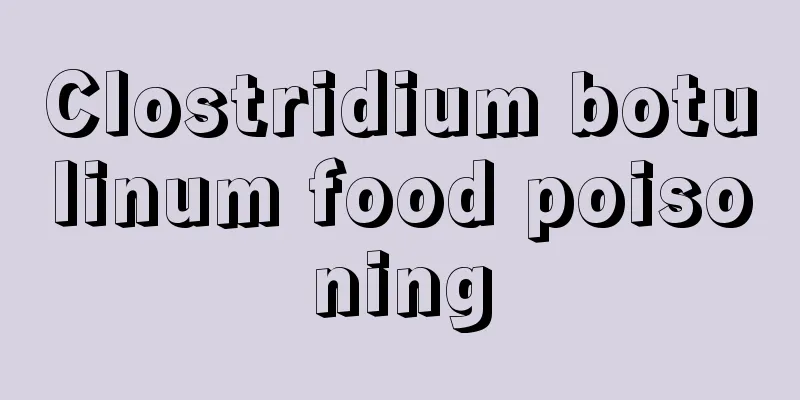Clostridium botulinum food poisoning

|
In life, we only know that food can be poisonous if it is not cooked properly, and that mushrooms can be poisoned if eaten improperly. However, we do not realize that many things can be poisonous and are closely related to our bodies, such as Clostridium botulinum food poisoning. This type of food poisoning requires careful understanding. What factors cause people to be poisoned, and under what circumstances will the poisoning occur? pathogen Clostridium botulinum (C. botulinum) food poisoning is caused by the exotoxin produced by Clostridium botulinum, namely botulinum toxin. The pathogen Clostridium botulinum is a Gram-positive, anaerobic, short and thick rod that forms oval spores that are thicker than the bacterial body at 20-25℃. When the pH is lower than 4.5 or greater than 9.0, or when the ambient temperature is lower than 15. C or above 55 ℃, Clostridium botulinum spores cannot reproduce and do not produce toxins. Clostridium botulinum spores are highly resistant and need to be subjected to high-pressure steam 121. C for 30 minutes, or dry heat at 180℃ for 5 to 15 minutes, or wet heat at 100℃ for 5 hours to kill it. Botulinum toxin is a strong neurotoxin that is 10,000 times more toxic than potassium cyanide. The lethal dose for humans is about 0.1 g. Depending on the antigenicity of the toxins produced, botulinum toxin is divided into 8 types: A, B, Ca, CB, D, E, F, and G. Four types, A, B, E, and F, cause human poisoning. Among them, types A and B are the most common. Most of the botulism poisoning reported in my country is type A, followed by types B and E. Unlike the typical exotoxin production method of other bacteria, botulinum toxin is not released by living bacteria, but first produces a non-toxic toxin precursor in the cytoplasm of living Clostridium botulinum. This precursor is a complex composed of a neurotoxin subunit and one or more non-toxin subunits. When the bacteria die and autolyze, the complex toxin precursor is released. This precursor is heat unstable and is destroyed by heating at 75-850°C for 5-15 minutes, or at 100°C for 1 minute. The complex form of botulinum toxin enters the stomach with food and can resist the digestion of gastric acid and enzymes. It enters the small intestine and is decomposed by small intestinal trypsin. Unlike the typical exotoxin production method of other bacteria, botulinum toxin is not released by living bacteria, but first produces a non-toxic toxin precursor in the cytoplasm of living Clostridium botulinum. This precursor is a complex composed of a neurotoxin subunit and one or more non-toxin subunits. When the bacteria die and autolyze, the complex toxin precursor is released. This precursor is heat unstable and is destroyed by heating at 75-85°C for 5-15 minutes, or at 100°C for 1 minute. The complex form of botulinum toxin enters the stomach with food and can resist the digestive effects of gastric acid and enzymes. It enters the small intestine, is broken down by small intestinal trypsin, and dissociates into neurotoxins in a higher pH environment, which are absorbed into the blood in the small intestine. |
<<: What to do if you get poisoned by eating lentils
>>: What to do if you are poisoned by hydrogen cyanide
Recommend
What ointment is good for sun rash
The scorching sun seems to pay special attention ...
How to treat advanced liver cancer with ascites
The male patient was 60 years old. He was diagnos...
Effective health care methods for brain cancer in real life
Brain cancer is a tumor disease that constantly a...
Anti-inflammatory and swelling points
When inflammation occurs in a certain part of the...
Does dishwashing liquid hurt your hands?
Dishwashing liquid is a kind of degreasing cleani...
One action can easily solve 7 minor body problems
1. If your nose is blocked, rub the area between ...
What to eat to treat gynecological problems
I believe everyone knows that food is the most im...
Women should pay as much attention as possible to the prevention of breast cancer
Among tumor diseases, breast cancer is a very com...
What is the treatment for throat herpes?
Throat herpes may be relatively unfamiliar to som...
Partially empty sella?
Empty sella is a very common phenomenon in clinic...
How to quickly solve the problem of getting drunk on the face
"People who blush when drinking alcohol don&...
What is the difference between nerve center and central nervous system
What is the difference between the nerve center a...
What should I do if the red spots from mosquito bites don’t go away?
Mosquito bites are very annoying because they can...
Can I go to a regular hospital for colorectal cancer?
As the saying goes: Disease comes from the mouth....
There are white things on both sides of the tonsils
Many people who have suffered from tonsillitis kn...









